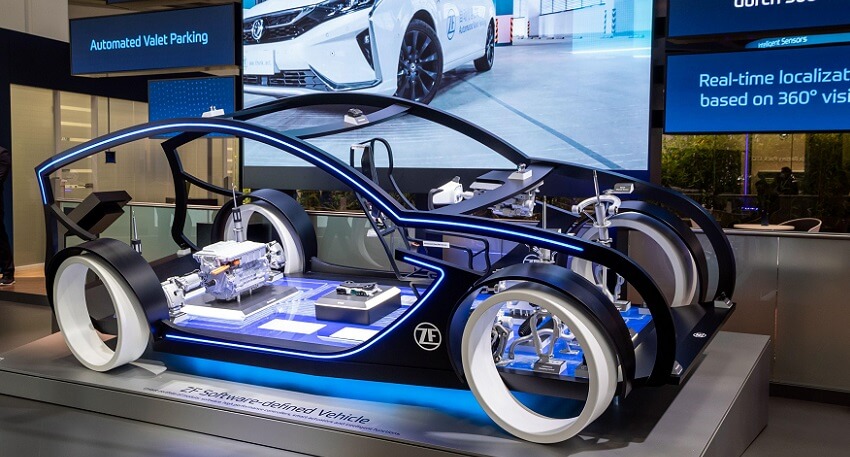Software-Defined Vehicles: Ready to Hit the Road
Forget about horsepower and torque, next-generation cars and trucks will be primarily defined by their software performance.

A software-defined vehicle (SDV) is a car or truck with features and functions primarily enabled through software. Thanks to recent software advancements, all types of road vehicles are rapidly transitioning from primarily hardware-based platforms into software-centric electronic devices on wheels.
The move toward the SDV marks a paradigm shift that OEMs and their suppliers are utilizing to build and support specific features, such as in-vehicle-infotainment, safety displays, internal monitoring capabilities, advanced driver-assist systems (ADAS), and autonomous driving (AD), says Stefano Marzani, worldwide tech leader of software-defined vehicles at Amazon Web Services, in an email interview.
With SDVs, OEMs and their suppliers can build and deliver customer-centric features via software updates at vehicle launch and throughout the vehicle's lifecycle to match both driver and passenger needs. "SDVs introduce new opportunities for customer loyalty, and OEM revenue," Marzani observes.
Multiple Routes
In a software-defined vehicle, key functions traditionally handled by dedicated hardware are consolidated and run on a more powerful centralized computing platform, says Jack Weast, vice president and general manager of Intel Automotive, in an email interview. This means that major functions, such as engine control, safety systems, infotainment services, and other operations are virtualized and executed through hardware and software applications. "Centralization allows for more efficient processing and communication between different vehicle systems," he notes.
Another important benefit is the ability to upgrade vehicle features through over-the-air (OTA) updates, similar to how smartphones are updated with new features and become better products over time, Marzani says. "This gives automakers the capability to continue to improve their vehicles over time as needed, such as offering on-demand features and subscription services."
Software updates delivered directly to an SDV can instantly add new features, fix newly discovered issues, and improve efficiency without the need for extensive hardware modifications or recalls. "By establishing one uniform software architecture for the entire vehicle range, management and maintenance of vehicle software will be much more scalable," Weast says.
"SDVs also allow automakers to slash costs by consolidating the number of electronic control units (ECUs) -- embedded systems that control one or more electrical systems or subsystems," Marzani notes.
Opportunities and Challenges
By consolidating the number of ECUs and shifting to a more software-focused approach, automakers hope to reduce development times for new features and functions. "Automakers do this through 'environmental parity', which allows automotive developers to use the cloud and virtualized versions of control units to develop software for hardware that may not yet even exist," Marzani says.
Weast believes that the automotive industry must transition to a software-defined architecture that's designed to consolidate workloads. "Today, every time OEMs want to add a new feature, they must add a new ECU box, and with each box comes more cabling," he explains. "This adds complexity along with legacy design challenges that's unsustainable architecturally and economically."
Next-generation in-vehicle information and entertainment environments are beginning to draw a new generation of vendors into the automotive industry, says Moritz Neukirchner, senior director and strategic manager of software-defined vehicles with automotive software provider Elektrobit, via email. He notes that a growing number of companies in smartphone-related fields, including entertainment and information app vendors, are now targeting the SDV market. That's also good news for cloud vendors, such as AWS and Google, which are now increasingly targeting the in-vehicle experience domain, Neukirchner says.
Security Concerns
Mike Pedrick, vice president of cybersecurity consulting with managed security services provider Nuspire, worries that improperly secured access methodologies could give determined attackers direct access to a vehicle's onboard systems. "Once in, the attacker could steal the car or compromise its functionality," he warns in an email interview. "Selectively disabling operational controls could endanger the vehicle's passengers."
Such a scenario is anything but far-fetched, Pedrick says. "It's already been nine years since researchers were able to remotely hijack the steering and braking systems in a 2015 model Jeep," he explains. "Today’s connected vehicles communicate over the same networks, using the same technologies as internet of things (IoT) devices, which are frequently commandeered to collect consumer data and launch distributed denial-of-service attacks against remote systems"
Down the Road
Looking ahead, a growing number of automotive OEMs are embracing generative AI (GenAI) in an effort to develop synthetic data for training autonomous driving systems. Once this goal has been reached, driving will become an entirely new experience, supported by personalized, ever-evolving assistants, guides, and entertainment services powered by GenAI. Such in-vehicle systems will be designed to respond to and learn from users' prompts, requests, and driving styles. Using GenAI, OEMs will also be able to design and build better car safety systems based on vast amounts of safety system data, Marzani says.
About the Author(s)
You May Also Like







